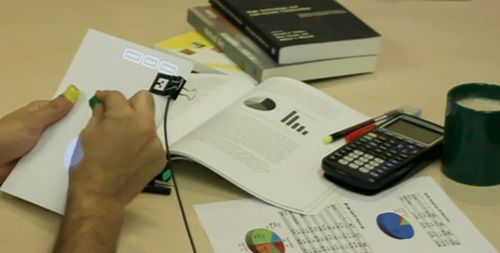When Pranav Mistry previewed this technology during an enthralling TED Talk in November 2009, he promised that, one day in the near future, developers would have access to the tools they needed to build their own "Sixth Sense" devices, open-source-style.
Sixth Sense uses hand gestures to control interactions as opposed to a mouse, trackball, or screen. Mistry's goal: To seamlessly connect the virtual and physical worlds in order to make the computing experience more intuitive. As a result, he wanted to remove the digital world from the confines of the smartphone or tablet and bring that world to everyday objects such as paper, walls, and t-shirts. "Rather than getting your camera out of your pocket, you can just do the gesture of taking a photo and it takes a photo for you," he said in the video.
The Future Is Here

In his TED talk, Pranav Mistry demonstrated his open-source-based technology that eliminates the need for typical screens or hardware, and uses "screens" such as paper, wrists, or walls to display data.
Recently Mistry lived up to his promise of sharing his powerful technology. The code andhardware component list (HCL) for Sixth Sense are now available. Wearable technology, as defined by Apple, Samsung, Dell, HP, and Microsoft, looks much different than the world Mistry envisioned four years ago. By offering this technology for free and open-source-style, Sixth Sense is definitely not on the same roadmap that the big boys of high tech are traveling.
The components you need to build a Sixth Sense device are both off-the-shelf andinexpensive. They include:
- Camera to capture the user’s hand movements and gestures, take pictures, and interpret users' “framing” gestures. Approximate cost: $50
- Projector for output (GUI), giving the ability to use virtually any surface as a “monitor,” as well as augmenting physical objects with real-time content. Approximate cost: $250
- Mirror measuring 1” x 1” as a physical relay for the projected image. Approximate cost: $5
- Microphone, used to enable paper as an interactive surface by capturing sound across the paper medium. With current camera tech, the microphone is usually part of the camera apparatus. Approximate cost: $0
- Mobile computing device -- smartphone or laptop. Approximate cost: Varies
That totals about $300 in hardware, all based on readily available, off-the-shelf components. That's not a huge investment, given the impact of the technology. Currently, no (or perhaps only a few) VARs are marketing Sixth Sense, although I predict this will change -- soon. Packaging the system with software to create a usable bundle of some wearable device at an inexpensive purchase price is inevitable.
Gaming platforms adopted gesture- and voice-based recognition, allowing for free-form game play and voice command for software manipulation. Microsoft, Apple, and BlackBerry accustomed users to control their devices via gesture and swipe commands. Now a new tier of tablet manufacturers can pull up a seat at the mobile table, given the low-cost barrier to entry and the potential market for vertical, specialized, inexpensive models, or diverse new wearable prototypes based on these open-source specs.
The table has been set for a truly intuitive platform to sweep the marketplace. I foresee the release of “Sixth Sense” as a free open-source alternative will have a big effect on an already explosive impact.

No comments:
Post a Comment